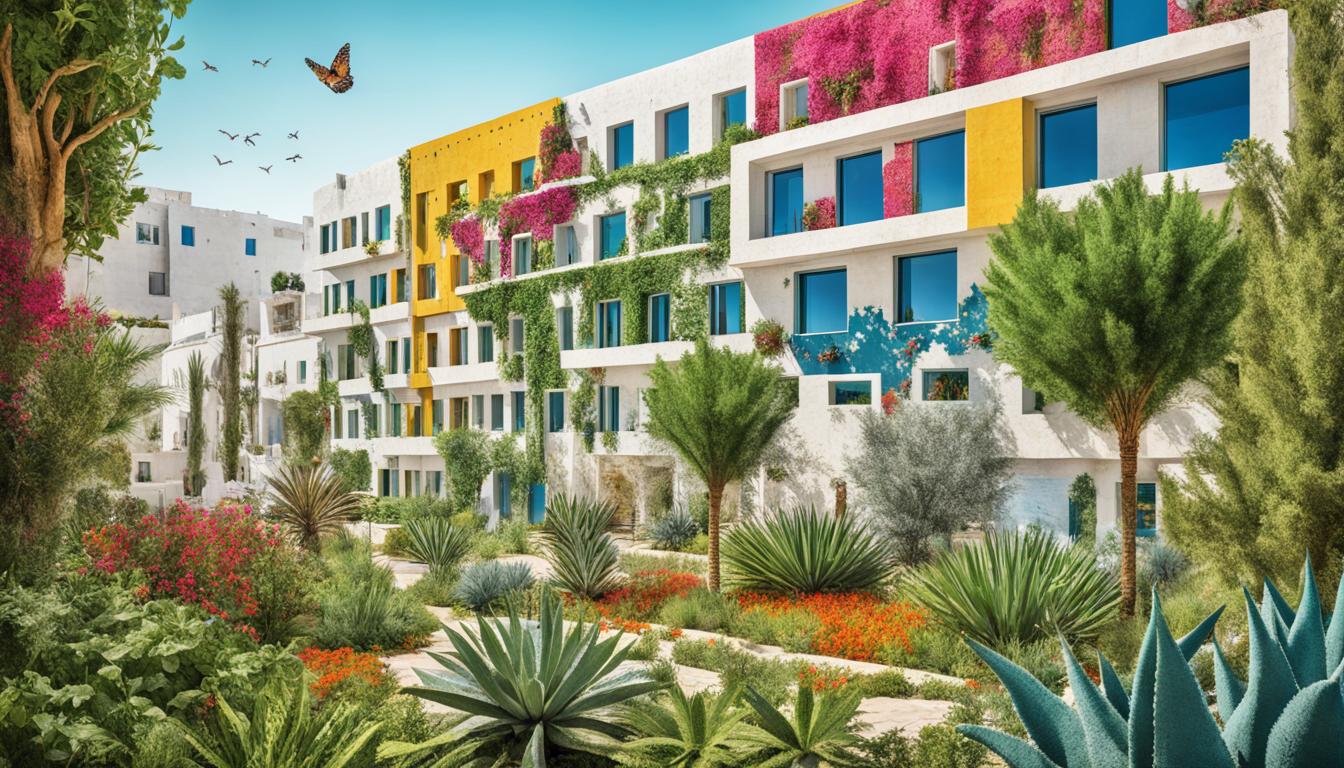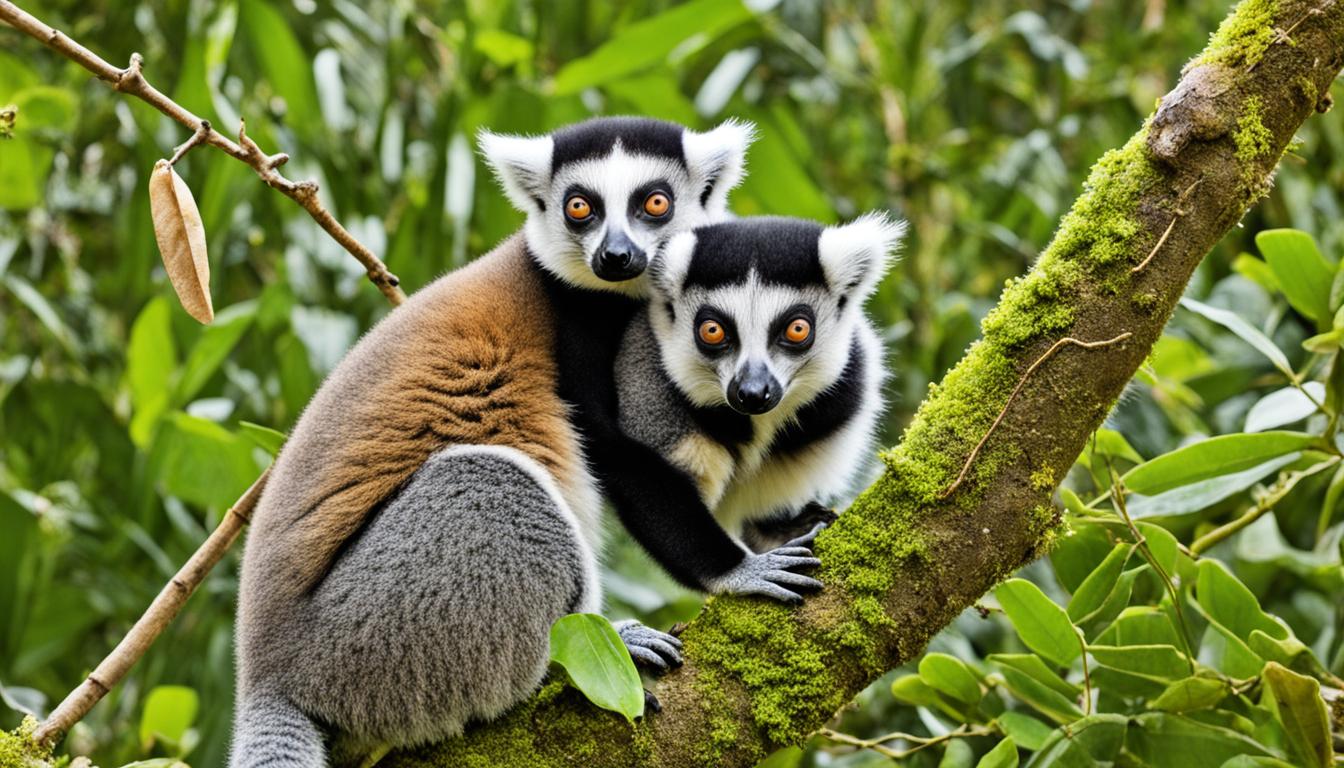Trinidad and Tobago Biodiversity and the Built Environment
Trinidad and Tobago is known for its rich biodiversity, diverse ecosystems, and unique animal and plant species. The preservation of this diverse natural heritage is vital for environmental sustainability and the well-being of both present and future generations. As the country focuses on urban development, it is crucial to integrate biodiversity conservation into the built environment to ensure a harmonious coexistence between nature and urban spaces.
The concept of green infrastructure and sustainable architecture plays a pivotal role in achieving this goal. By incorporating green spaces, such as parks and gardens, within urban designs, we can create sustainable ecosystems that provide numerous benefits, including cleaner air, improved water quality, and enhanced biodiversity. This ecological design approach not only supports the preservation of Trinidad and Tobago’s unique flora and fauna but also contributes to the well-being of its citizens by promoting a healthier and more vibrant living environment.
Ecosystem services, the invaluable benefits that nature provides to humans, are another essential aspect to consider. By integrating natural resources management practices into urban planning, we can ensure the sustainable use of resources and minimize the negative impacts of urbanization on biodiversity. From clean water supply to climate regulation, these ecosystem services are indispensable for the resilience and long-term sustainability of our communities.
As Trinidad and Tobago progresses towards a more sustainable future, it is our responsibility to implement effective conservation strategies and engage in a collective effort to protect and restore our natural habitats. By considering the connectivity between protected areas, preserving wildlife corridors, and raising awareness about the importance of biodiversity, we can foster a culture of environmental stewardship and ensure the preservation of our invaluable natural resources for generations to come.
Key Takeaways:
- Trinidad and Tobago’s biodiversity is under threat from habitat loss and illegal activities.
- Integrating biodiversity conservation into the built environment is crucial for sustainable urban development.
- Green infrastructure and sustainable architecture promote the coexistence of nature and urban spaces.
- Ecosystem services provided by nature are essential for the well-being of communities.
- Effective conservation strategies and awareness are crucial for the long-term preservation of Trinidad and Tobago’s biodiversity.
The Ecosystems of Trinidad and Tobago
Trinidad and Tobago is home to a diverse range of ecosystems that contribute to its unique biodiversity. From coastal mangroves to tropical rainforests, coral reefs to savannahs, these ecosystems provide critical habitats for a wide variety of flora and fauna.
Coastal mangroves, found along the shores, thrive in brackish water and act as a protective barrier against erosion. These mangroves provide shelter for numerous marine species and serve as important breeding grounds for fish and crustaceans. Additionally, they play a crucial role in filtering pollutants, improving water quality, and mitigating the impacts of climate change.
The tropical rainforests of Trinidad and Tobago are rich in biodiversity, with towering trees, lush vegetation, and an abundance of wildlife. These forests are home to countless species of plants, insects, birds, mammals, and reptiles, many of which are endemic to the region. The rainforests provide important ecosystem services, such as carbon sequestration and the regulation of water flow, contributing to the overall health of the environment.
The coral reefs surrounding the islands are a vibrant and delicate ecosystem. These reefs are teeming with marine life, including colorful fish, sea turtles, and various species of coral. The reefs not only provide habitat for a vast array of organisms but also protect the coastlines from erosion and provide opportunities for tourism and recreation.
The savannahs of Trinidad and Tobago are characterized by vast grasslands dotted with scattered trees. These open landscapes support a diverse range of plant and animal species adapted to this unique habitat. Savannahs are critical for grazing animals, serve as breeding grounds for birds, and play a role in nutrient cycling and fire maintenance.
“The diverse ecosystems of Trinidad and Tobago are vital for the conservation of biodiversity and the overall balance of nature in the region.”
By protecting and preserving these ecosystems, Trinidad and Tobago can ensure the continued existence of its diverse flora and fauna. Conservation efforts, including the establishment of protected areas and sustainable management practices, are essential for safeguarding these precious ecosystems for future generations.
| Ecosystem | Key Features |
|---|---|
| Coastal Mangroves | Protective barrier, breeding grounds, water filtration |
| Tropical Rainforests | Diverse flora and fauna, carbon sequestration, water regulation |
| Coral Reefs | Colorful marine life, coastal protection, tourism opportunities |
| Savannahs | Grasslands, diverse plant and animal species, nutrient cycling |
Unique Animal Species in Trinidad and Tobago
Trinidad and Tobago is a treasure trove of unique animal species that contribute to the region’s rich biodiversity. One such species is the critically endangered Trinidad piping-guan, a magnificent bird found only on these islands. This majestic creature, with its distinctive call and striking appearance, epitomizes the beauty and diversity of the local avifauna. However, Trinidad and Tobago’s animal kingdom extends far beyond this extraordinary bird.
The islands are also home to a diverse array of bird species. From vibrant hummingbirds to elusive raptors, these feathered creatures captivate both birdwatchers and nature enthusiasts. Additionally, Trinidad and Tobago provide habitats for a variety of mammals, reptiles, and amphibians, adding to the ecological tapestry of the land.
Notable Bird Species
Trinidad and Tobago’s bird species encompass a wide range of sizes, colors, and behaviors. Some of the notable avian inhabitants include:
| Bird Species | Description |
|---|---|
| Scarlet Ibis | The vibrant red plumage of the Scarlet Ibis makes it a striking sight. These beautiful birds gather in large flocks, creating a mesmerizing spectacle. |
| Crimson Topaz Hummingbird | The tiny yet glorious Crimson Topaz Hummingbird showcases iridescent plumage and agile flight patterns, mesmerizing onlookers. |
Diverse Mammals, Reptiles, and Amphibians
Trinidad and Tobago’s lush forests, coastal habitats, and wetlands harbor numerous fascinating mammals, reptiles, and amphibians. These include:
- West Indian Manatee: These gentle giants can be spotted in the coastal waters of Trinidad and Tobago, captivating observers with their lumbering grace.
- Leatherback Sea Turtle: The pristine beaches of Trinidad and Tobago serve as nesting grounds for these ancient creatures, and witnessing the arduous journey from egg to sea is a truly extraordinary experience.
From the slithering elegance of anacondas to the vibrant hues of tree frogs, the reptiles and amphibians in Trinidad and Tobago add a unique charm to the islands’ natural heritage. Exploring their habitats reveals a world teeming with variety and wonder.
In conclusion, Trinidad and Tobago’s unique animal species, including the critically endangered Trinidad piping-guan, along with its diverse bird, mammal, reptile, and amphibian populations, contribute to the region’s extraordinary biodiversity. Preserving and appreciating these remarkable creatures is crucial for the sustainable future of the islands’ ecosystems and the conservation of their natural treasures.
Notable Animal Species in Trinidad and Tobago
Trinidad and Tobago is home to several notable animal species that contribute to the region’s biodiversity. These species, including the Scarlet Ibis, West Indian Manatee, Leatherback Sea Turtle, and Crimson Topaz Hummingbird, are recognized for their unique characteristics and ecological importance.
Scarlet Ibis
The Scarlet Ibis (Eudocimus ruber) is a striking bird species known for its vibrant red plumage. These birds are native to the wetlands of Trinidad and Tobago, where they feed on crustaceans, insects, and small fish. Their presence is a testament to the country’s rich avian diversity.
West Indian Manatee
The West Indian Manatee (Trichechus manatus) is a large marine mammal that inhabits the coastal waters of Trinidad and Tobago. These gentle giants are herbivores, feeding on aquatic vegetation. They are considered endangered and are protected under Trinidad and Tobago’s conservation efforts.
Leatherback Sea Turtle
The Leatherback Sea Turtle (Dermochelys coriacea) is the largest species of sea turtle and can be found nesting on the shores of Trinidad and Tobago. These turtles undertake arduous migratory journeys and are known for their distinctive leathery shells. Conserving the nesting sites of Leatherback Sea Turtles is crucial for their survival.
Crimson Topaz Hummingbird
The Crimson Topaz Hummingbird (Topaza pella) is a stunning bird species known for its metallic green feathers and bright red throat patch. These hummingbirds are found in the forests of Trinidad and Tobago and play a vital role in pollination. Their presence highlights the diverse array of bird species in the region.
“The Scarlet Ibis, West Indian Manatee, Leatherback Sea Turtle, and Crimson Topaz Hummingbird are just a few examples of the remarkable animal species that make Trinidad and Tobago a biodiversity hotspot.” – Trinidad and Tobago’s Ministry of Agriculture, Land, and Fisheries
To further showcase the notable animal species found in Trinidad and Tobago, refer to the table below:
| Animal Species | Scientific Name | Habitat | Conservation Status |
|---|---|---|---|
| Scarlet Ibis | Eudocimus ruber | Wetlands | Vulnerable |
| West Indian Manatee | Trichechus manatus | Coastal waters | Endangered |
| Leatherback Sea Turtle | Dermochelys coriacea | Nesting beaches | Critically Endangered |
| Crimson Topaz Hummingbird | Topaza pella | Forests | Least Concern |
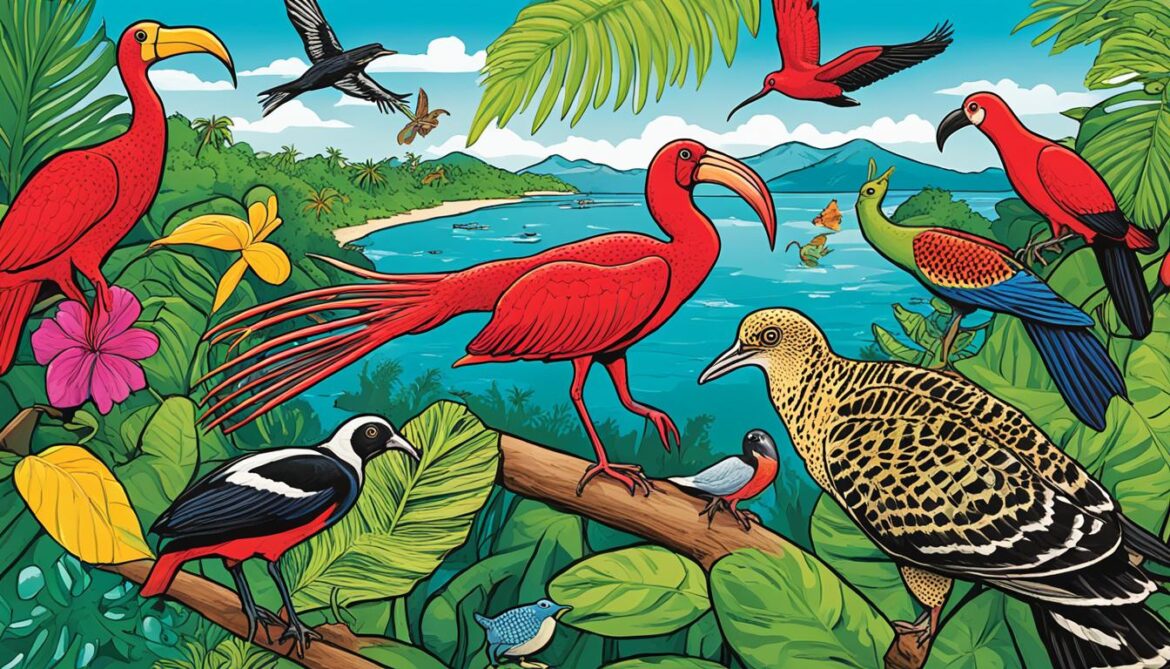
These notable animal species in Trinidad and Tobago serve as important indicators of the country’s ecological health and emphasize the need for their conservation. Protecting their habitats and raising awareness about their importance contributes to the overall preservation of Trinidad and Tobago’s rich biodiversity.
Rich Plant Diversity in Trinidad and Tobago
Trinidad and Tobago boasts an extraordinary array of plant species, making it a paradise for botany enthusiasts and nature lovers alike. With approximately 2,500 species of plants, including 110 believed to be endemic, the islands are renowned for their rich plant diversity.
The vegetation communities found in Trinidad and Tobago encompass various ecosystems, each contributing to the region’s exceptional plant life. The rainforests, with their dense canopies and lush undergrowth, are home to a myriad of plant species, offering a haven for biodiversity. From towering trees to delicate ferns, these rainforests support a diverse range of flora, each with its unique adaptations and characteristics.
Aside from rainforests, Trinidad and Tobago also boasts other distinct vegetation communities. Littoral woodlands, found along the coast, thrive in the challenging conditions of sandy soil and salty air. These communities are home to unique plant species that have adapted to survive in this coastal environment.
Deciduous seasonal woodlands, found in the southern part of the islands, experience a distinctive dry season. Despite this challenge, a variety of plants manage to thrive and contribute to the overall floral diversity of the region.
Finally, the swamp forests, found in low-lying areas, are vital ecosystems that support various plant species, including palms. Palms, with their iconic and distinctive appearance, are an integral part of Trinidad and Tobago’s plant diversity.
The rich plant diversity found in Trinidad and Tobago provides critical habitats for numerous animal species and plays a significant role in maintaining the delicate balance of the region’s ecosystems. It is imperative that we continue to protect and conserve these vegetation communities to safeguard the unique plant life and ensure the resilience of Trinidad and Tobago’s biodiversity for generations to come.
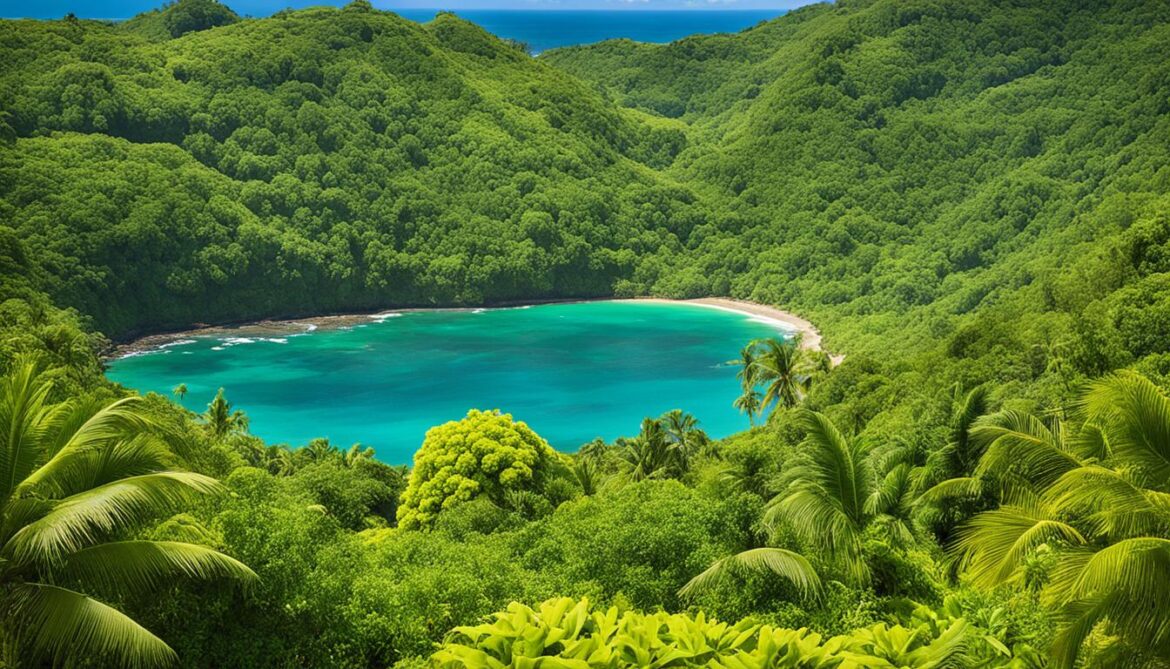
Some Notable Plant Species in Trinidad and Tobago:
- Blue Mahoe (Hibiscus elatus)
- Mountain Immortelle (Erythrina poeppigiana)
- Pitch Apple (Clusia rosea)
- Poui (Tabebuia spp.)
- Chaconia (Warszewiczia coccinea)
Conservation Efforts and Protected Areas in Trinidad and Tobago
Trinidad and Tobago is committed to preserving its biodiversity through dedicated conservation efforts and the establishment of protected areas. Currently, there are approximately 75 protected areas across the country, including National Parks, that play a crucial role in safeguarding the diverse ecosystems and unique species found within Trinidad and Tobago.
Conservation efforts are supported by legislation that ensures the protection and sustainable management of natural resources. This legislation is continuously updated to address emerging environmental challenges and promote effective conservation practices.
To further strengthen conservation initiatives, there has been an increase in staffing, with trained professionals dedicated to managing and monitoring protected areas. These individuals work tirelessly to preserve the delicate balance of Trinidad and Tobago’s ecosystems and the species that depend on them.
Educational programs and awareness campaigns also play a significant role in promoting biodiversity conservation in Trinidad and Tobago. These initiatives aim to educate the public about the importance of protected areas, the value of ecosystem services, and the need for sustainable practices in everyday life.
“Conserving our natural heritage is a shared responsibility. Together, we can protect Trinidad and Tobago’s biodiversity for present and future generations.”
By fostering a culture of environmental awareness and appreciation, Trinidad and Tobago is paving the way for a more sustainable future. Through collaborative efforts and a commitment to biodiversity conservation, the country is ensuring the preservation of its rich natural resources and the ecosystems they sustain.
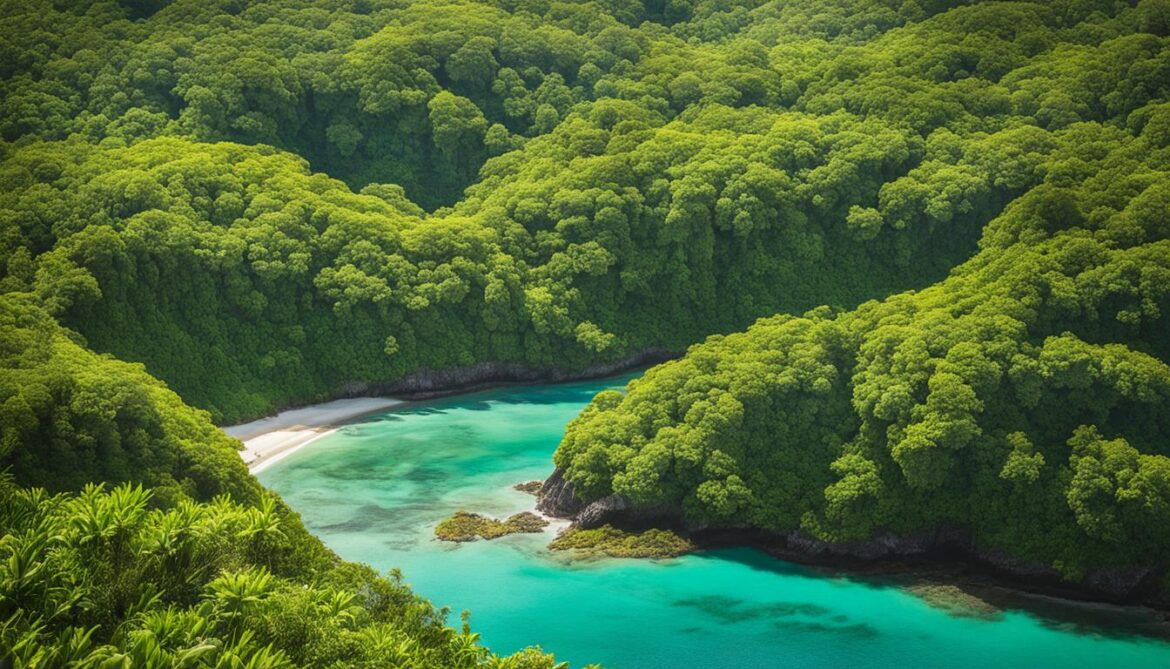
The Importance of Protected Areas
Protected areas in Trinidad and Tobago serve as havens for threatened and endangered species, allowing them to thrive in their natural habitats without the pressures of human interference. These areas act as vital corridors for the movement of wildlife and facilitate genetic diversity, essential for long-term species survival.
Furthermore, protected areas provide opportunities for scientific research and monitoring, enabling experts to better understand the intricate relationships between species and ecosystems. This knowledge is invaluable in formulating effective conservation strategies and informing decision-making processes.
| Benefits of Protected Areas | Examples |
|---|---|
| Preservation of biodiversity | North-East Tobago Marine Park |
| Conservation of endangered species | Trinity Hills Wildlife Sanctuary |
| Protection of critical habitats | Aripo Savannah National Park |
| Enhancement of ecosystem services | Matura National Park |
Threats to Biodiversity in Trinidad and Tobago
Despite conservation efforts, Trinidad and Tobago’s biodiversity faces significant challenges from various sources. These threats to biodiversity include habitat loss, illegal activities, timber exploitation, agriculture, and forest fires. The consequences of these threats are disastrous for the diverse species and ecosystems found in the region.
Habitat Loss
Habitat loss is a critical factor contributing to the decline of biodiversity in Trinidad and Tobago. Rapid urbanization and infrastructure development result in the destruction and fragmentation of natural habitats, pushing species to the brink of extinction. The expansion of human activities into these areas disrupts crucial ecological processes and disrupts the balance of fragile ecosystems.
Illegal Activities
Illegal activities, such as poaching and wildlife trafficking, pose a significant threat to the biodiversity of Trinidad and Tobago. These activities disrupt natural ecological systems and deplete populations of vulnerable species. The illegal trade in exotic animals and their parts further perpetuates the problem, putting unique animal species at risk of extinction.
Timber Exploitation
Unregulated timber exploitation has a detrimental impact on Trinidad and Tobago’s biodiversity. Deforestation for timber extraction disrupts forest ecosystems, leading to the loss of critical habitats for various plant and animal species. The removal of trees also contributes to soil erosion, water pollution, and carbon emissions, exacerbating climate change and further endangering biodiversity.
Agriculture
Intensive agriculture, including the expansion of crops and livestock farming, poses a significant threat to biodiversity in Trinidad and Tobago. The conversion of natural habitats into agricultural land reduces available space for wildlife, displaces native species, and disrupts ecological balance. The use of pesticides and fertilizers in agricultural practices also harms local flora and fauna, affecting their survival and contributing to biodiversity loss.
Forest Fires
Forest fires, both natural and human-induced, have a severe impact on the biodiversity of Trinidad and Tobago. These fires destroy vast areas of forests, resulting in the loss of habitats for numerous plant and animal species. Additionally, the smoke and emissions from these fires have adverse effects on air quality and carbon sequestration, further contributing to environmental degradation.
“The destruction and degradation caused by habitat loss, illegal activities, timber exploitation, agriculture, and forest fires are threatening the precious biodiversity of Trinidad and Tobago. Urgent action is required to protect and restore these ecosystems before irreversible damage occurs.”
To better understand the extent of the threats and formulate effective conservation strategies, comprehensive data collection and ongoing monitoring of Trinidad and Tobago’s biodiversity are essential. Such efforts will help inform decision-makers, enabling them to make informed choices that prioritize the preservation and sustainable management of the region’s rich natural heritage.
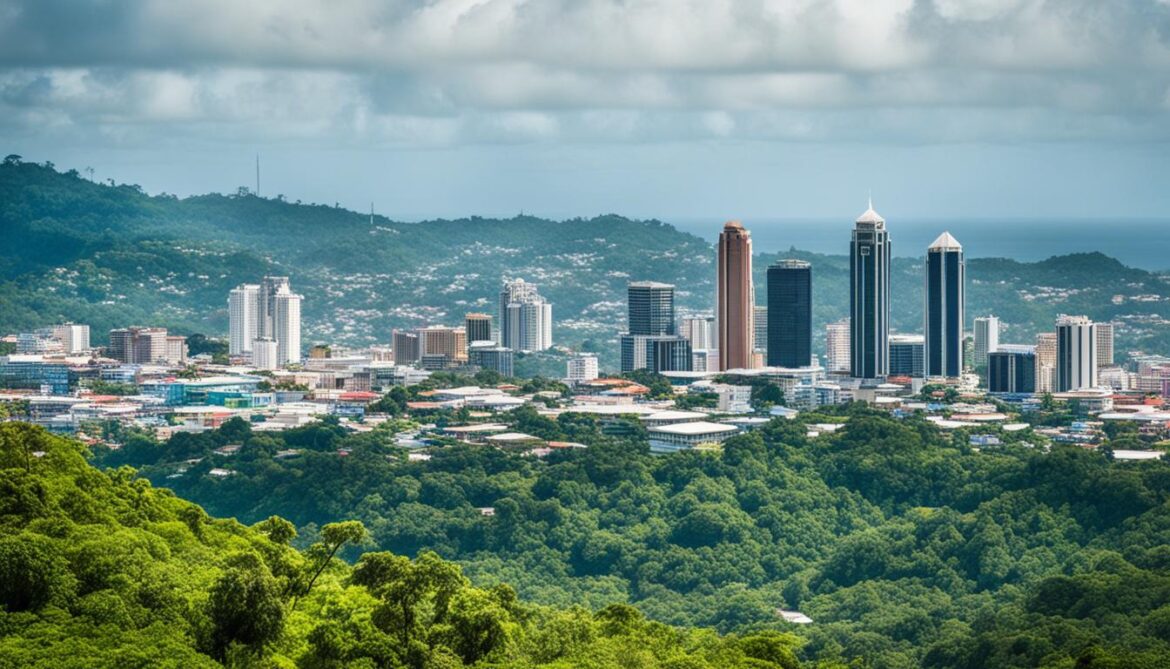
| Threat Type | Impact |
|---|---|
| Habitat Loss | Disruption of ecological processes and loss of critical habitats |
| Illegal Activities | Population depletion and extinction risk for vulnerable species |
| Timber Exploitation | Deforestation, soil erosion, and water pollution |
| Agriculture | Displacement of native species and harm to local flora and fauna |
| Forest Fires | Destruction of forest ecosystems and loss of habitats |
Implementation of the National Biodiversity Strategy and Action Plan (NBSAP)
The Government of Trinidad and Tobago developed the National Biodiversity Strategy and Action Plan (NBSAP) in 2001. The NBSAP plays a vital role in improving biodiversity conservation efforts and ensuring the sustainable management of Trinidad and Tobago’s natural resources.
The NBSAP encompasses various strategies and actions aimed at enhancing stakeholder engagement, implementing effective conservation strategies, promoting education and awareness, enacting relevant legislation, facilitating information dissemination, and supporting research initiatives.
“The NBSAP serves as a comprehensive roadmap for safeguarding Trinidad and Tobago’s biodiversity. It emphasizes the importance of engaging stakeholders from all sectors, including government agencies, local communities, non-profit organizations, and the private sector, in the conservation efforts,” says Dr. Maria Gomez, an expert in biodiversity conservation.
Since the establishment of the NBSAP, significant progress has been made in regulating development activities and enhancing the protection of key areas and species. Stakeholder engagement has increased, allowing for collaboration and knowledge-sharing among diverse groups involved in biodiversity conservation.
Conservation strategies identified in the NBSAP include the establishment and management of protected areas, habitat restoration, sustainable land and water management practices, and the integration of biodiversity considerations in land-use planning and development policies.
Education and awareness play a crucial role in the NBSAP, aiming to foster a greater understanding of the importance of biodiversity and the need for its conservation. This includes educational programs for schools and local communities, as well as awareness campaigns targeting the general public to promote sustainable behaviors and practices.
Legislation is another key aspect of the NBSAP, with the implementation of laws and regulations that protect Trinidad and Tobago’s biodiversity and enforce sustainable resource management practices. This involves the development of policies and regulations that promote conservation, regulate activities that may pose risks to biodiversity, and deter illegal practices.
Information is critical for effective biodiversity conservation. The NBSAP emphasizes the importance of gathering and disseminating data on Trinidad and Tobago’s biodiversity, including species inventories, ecological assessments, and monitoring programs. This information enables evidence-based decision-making and supports the development of targeted conservation actions.
Research is an essential component of the NBSAP, encouraging scientific studies and investigations to address knowledge gaps and inform conservation strategies. This includes research on threatened species, ecosystem dynamics, climate change impacts, and sustainable resource management practices.
The implementation of the National Biodiversity Strategy and Action Plan in Trinidad and Tobago represents a significant step towards conserving and protecting the country’s unique biodiversity. Through stakeholder engagement, effective conservation strategies, education, legislation, information dissemination, and research, Trinidad and Tobago is making notable progress towards achieving its biodiversity conservation goals and ensuring the preservation of its natural heritage for future generations.
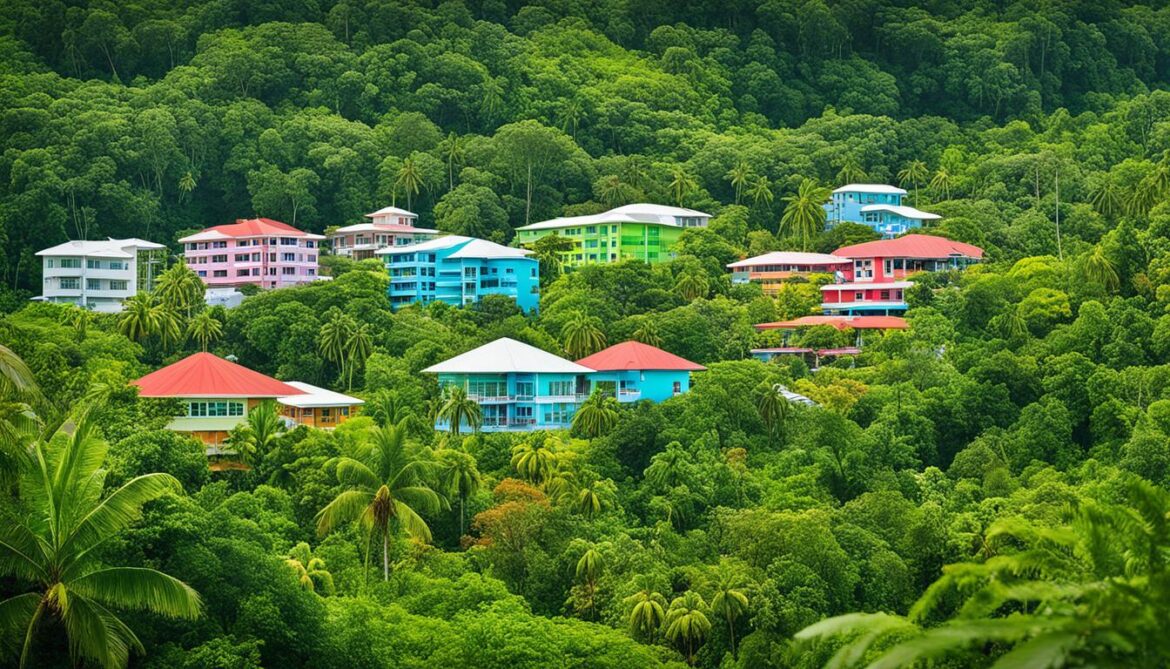
Actions to Achieve the 2020 Aichi Biodiversity Targets
Trinidad and Tobago is committed to taking significant actions to achieve the 2020 Aichi Biodiversity Targets. These actions encompass a range of initiatives aimed at preserving and restoring the country’s rich biodiversity and promoting sustainable practices.
Reforestation and Watershed Rehabilitation Programs
One of the key actions undertaken by Trinidad and Tobago is the implementation of reforestation and watershed rehabilitation programs. These initiatives involve planting trees and restoring degraded areas to enhance ecosystem resilience, conserve water resources, and provide vital habitats for environmentally sensitive species.
Designation of Environmentally Sensitive Species
Trinidad and Tobago recognizes the importance of identifying and safeguarding environmentally sensitive species. Through the designation of these species, efforts are focused on their conservation and habitat preservation. This helps maintain the ecological balance and protect critical components of the country’s biodiversity.
Integration of Biodiversity Management into Community Programs
Achieving the 2020 Aichi Biodiversity Targets requires active community involvement. Trinidad and Tobago has integrated biodiversity management into community programs to raise awareness and promote actions that support biodiversity conservation. By engaging communities, the country aims to foster a sense of responsibility and collective action towards protecting local ecosystems and species.
Protection of Agricultural Genetic Diversity
Preserving agricultural genetic diversity is crucial for sustainable food production and the resilience of Trinidad and Tobago’s agricultural sector. The country is actively working towards the protection and conservation of indigenous crops and traditional farming practices, ensuring the long-term viability of its agricultural resources.
Promotion of Sustainable Consumption Practices
Sustainable consumption practices play a vital role in reducing the negative impact on biodiversity. Trinidad and Tobago promotes sustainable consumption by encouraging responsible choices, supporting local and organic products, and raising awareness about the importance of biodiversity conservation in everyday life.
| Action | Description |
|---|---|
| Reforestation and Watershed Rehabilitation Programs | Implementing initiatives to restore degraded areas and enhance ecosystem resilience. |
| Designation of Environmentally Sensitive Species | Identifying and safeguarding species that are critical to the ecological balance. |
| Integration of Biodiversity Management into Community Programs | Promoting community involvement and action for biodiversity conservation. |
| Protection of Agricultural Genetic Diversity | Preserving indigenous crops and traditional farming practices. |
| Promotion of Sustainable Consumption Practices | Raising awareness and encouraging responsible choices in everyday life. |
Through these actions, Trinidad and Tobago is actively contributing to the global efforts in achieving the 2020 Aichi Biodiversity Targets. By prioritizing reforestation, watershed rehabilitation, the protection of environmentally sensitive species, and the integration of biodiversity management into community programs, the country is working towards a more sustainable and biodiverse future.
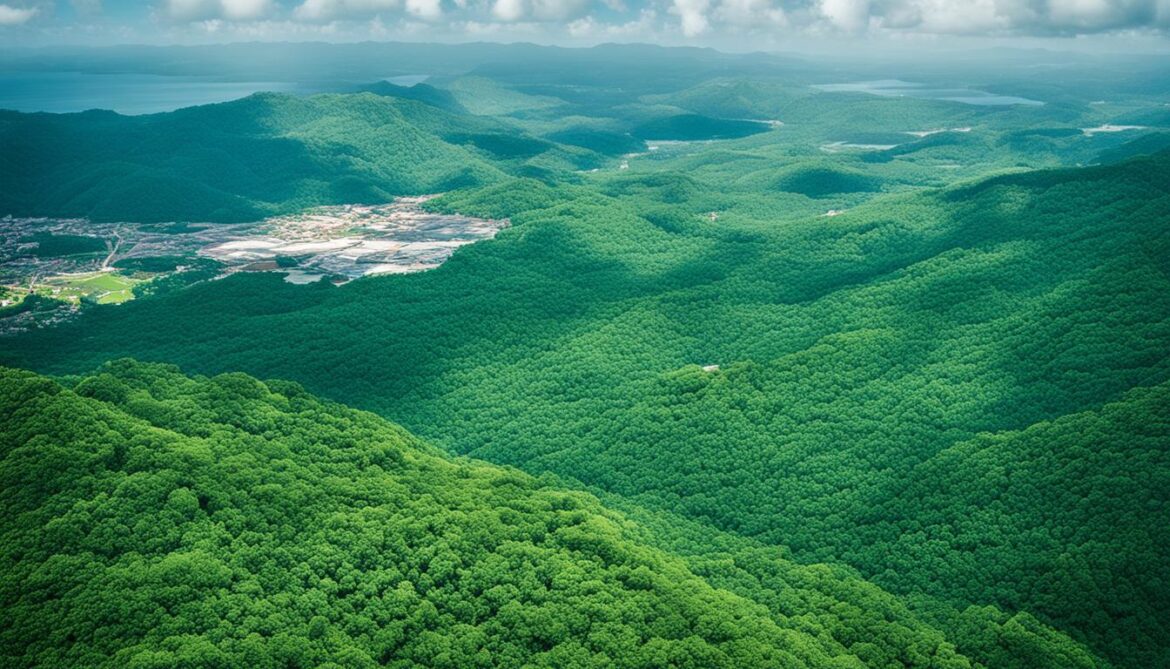
Support Mechanisms for National Implementation
Trinidad and Tobago has implemented various support mechanisms to ensure the effective implementation of biodiversity conservation measures. These mechanisms play a crucial role in safeguarding the unique natural heritage of the country. Key support mechanisms include legislation, funding sources like the Green Fund, capacity-building initiatives, coordination efforts between government ministries and stakeholders, and the mainstreaming of environmental considerations into various sectors.
The implementation of effective legislation is essential for biodiversity conservation. Trinidad and Tobago has established laws and regulations that govern the protection and management of natural resources. These legislative measures help in preventing habitat destruction, mitigating the impacts of illegal activities, and promoting sustainable practices.
Funding plays a vital role in supporting biodiversity conservation initiatives. The Green Fund, established by the government, provides financial resources for projects that promote environmental sustainability and biodiversity conservation. These funds are utilized for activities such as habitat restoration, species conservation, and public awareness campaigns.
Capacity-building initiatives are crucial for building the necessary skills and knowledge required for effective biodiversity conservation. Trinidad and Tobago invests in training programs and educational opportunities to enhance the expertise of individuals involved in biodiversity management. These initiatives ensure that professionals have the necessary tools and knowledge to address conservation challenges.
Coordination efforts between government ministries and stakeholders are essential for successful biodiversity conservation. Trinidad and Tobago has established coordination mechanisms that bring together relevant stakeholders, including government agencies, non-governmental organizations, and local communities. This collaboration helps in developing and implementing integrated strategies that contribute to the conservation and sustainable use of biological resources.
Mainstreaming environmental considerations into various sectors is another important support mechanism in Trinidad and Tobago. By integrating biodiversity conservation into sectors such as agriculture, tourism, and urban planning, the country ensures that environmental considerations are prioritized in decision-making processes. This approach promotes sustainable development practices that minimize the negative impacts on biodiversity.
Overall, the implementation of support mechanisms like legislation, funding, capacity-building initiatives, coordination efforts, and mainstreaming of environmental considerations is vital for the successful conservation and sustainable management of Trinidad and Tobago’s unique biodiversity.
Sustainable Communities in Central America and the Caribbean
Sustainable communities in Central America and the Caribbean, including Trinidad and Tobago, prioritize sustainable architecture, zero energy buildings, and green infrastructure. These initiatives aim to create environmentally friendly urban spaces that emphasize energy efficiency, waste reduction, and the use of sustainable building materials. By integrating sustainable practices into urban planning, these communities aim to achieve long-term environmental sustainability and enhance the quality of life for residents.

Sustainable architecture plays a crucial role in the development of sustainable communities. It involves designing and constructing buildings that minimize energy consumption, utilize renewable energy sources, and incorporate sustainable materials. The goal is to reduce the carbon footprint of buildings while creating comfortable and efficient spaces for residents.
“Zero energy buildings” are a key component of sustainable communities. These buildings generate as much energy as they consume through renewable sources. They often utilize solar panels, wind turbines, or geothermal systems to meet their energy needs, thereby significantly reducing reliance on fossil fuels.
Green buildings are another essential feature of sustainable communities. These buildings are designed and constructed to have a minimal impact on the environment throughout their entire lifecycle. They incorporate sustainable materials, employ energy-efficient systems, and prioritize water conservation. Green buildings contribute to a healthier and more sustainable built environment.
Sustainable Urban Planning
Urban planning plays a vital role in the development of sustainable communities. It involves the integration of environmental, social, and economic considerations to create livable and resilient urban spaces. Sustainable urban planning focuses on efficient land use, the promotion of public transportation systems, the creation of green spaces, and the protection of natural resources.
- Promoting compact and mixed-use developments reduces the need for excessive transportation, minimizes urban sprawl, and supports a sense of community.
- Incorporating green spaces, such as parks and gardens, helps enhance the overall well-being of residents, provide recreational opportunities, and improve air quality.
- The preservation of natural resources, such as water bodies, wetlands, and forests, is essential for maintaining ecological balance and preserving biodiversity.
Effective sustainable urban planning requires collaboration between government agencies, architects, urban designers, and community stakeholders. By integrating environmentally conscious practices into urban development, Central American and Caribbean countries, including Trinidad and Tobago, can create sustainable communities that harmonize with nature, minimize environmental impacts, and enhance the quality of life for their residents.
| Sustainable Communities | Sustainable Architecture | Zero Energy Buildings | Green Buildings | Urban Planning |
|---|---|---|---|---|
| Focus on creating environmentally friendly urban spaces | Design and construct buildings with minimal energy consumption | Generate as much energy as they consume through renewable sources | Designed and constructed to have a minimal impact on the environment | Integration of environmental, social, and economic considerations in urban development |
| Emphasize energy efficiency and waste reduction | Incorporate sustainable materials and renewable energy sources | Reduce reliance on fossil fuels and promote renewable energy | Utilize energy-efficient systems and prioritize water conservation | Promote efficient land use and public transportation systems |
| Use sustainable building materials | Create comfortable and efficient spaces | Reduce greenhouse gas emissions | Contribute to a healthier and more sustainable built environment | Create green spaces and preserve natural resources |
Conclusion
The biodiversity of Trinidad and Tobago is a valuable resource that must be protected through conservation efforts and sustainable development. By integrating biodiversity considerations into the built environment, Trinidad and Tobago can achieve sustainable urban development and preserve its unique natural heritage for future generations.
The conservation efforts and protected areas in Trinidad and Tobago play a crucial role in safeguarding the diverse ecosystems and unique animal species found in the region. These efforts involve legislation, increased staffing, education, and awareness programs aimed at promoting the sustainable management of the country’s natural resources.
Through the implementation of the National Biodiversity Strategy and Action Plan (NBSAP) and actions to achieve the 2020 Aichi Biodiversity Targets, Trinidad and Tobago is taking significant steps towards biodiversity conservation. Support mechanisms such as legislation, funding, capacity-building, and coordination further contribute to the successful implementation of conservation measures.
By prioritizing sustainable architecture, zero energy buildings, and green infrastructure, Trinidad and Tobago, along with other sustainable communities in Central America and the Caribbean, is leading the way in sustainable urban development. These initiatives promote energy efficiency and waste reduction, creating environmentally friendly urban spaces that preserve the region’s unique natural heritage.





